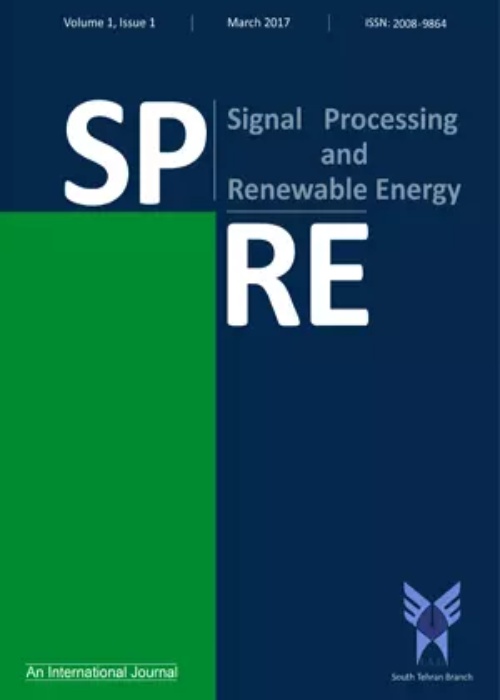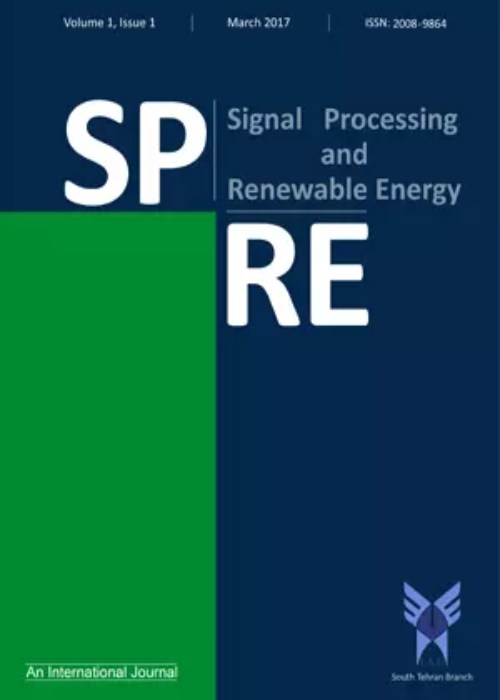فهرست مطالب

Signal Processing and Renewable Energy
Volume:7 Issue: 3, Summer 2023
- تاریخ انتشار: 1402/06/10
- تعداد عناوین: 6
-
Pages 1-11Epilepsy is a chronic disorder and outbreak of brain function, caused by the abnormal and intermittent electric discharge of brain neurons. Electroencephalogram signals represent brain activities, and one of the methods of diagnosing epilepsy is using EEG brain signals. In this article, a new method for diagnosing epilepsy using EEG signal processing is presented. At first, the EEG signal is divided into five frequency sub-bands using Discrete Wavelet Transformation (DWT). Then, the features are extracted from five frequency sub-bands, and the best features are selected by the analysis of variance (ANOVA) method. Finally, by using the Support Vector Machine (SVM) algorithm, these features are used to classify seizure and non-seizure EEG signals. The simulation results from the Bonn university dataset affirm the suggested approach's advantage in comparison with some other basic classical methods in terms of accuracy, sensitivity, and specificit.Keywords: Epileptic Seizure, Features selection, Electroencephalogram signals, Support vector machine (SVM)
-
Pages 13-29Recently, image segmentation based on graph cut methods has shown impressive performance on a set of image data. Although the kernel graph cut method provides good performance, its performance is highly dependent on the data mapping to the transformation space and image features. Entropy-based kernel graph cut method is suitable for segmentation of textured images. However, the quality of its segmentation is affected by the quality of extracting kernel centers. This paper examines the segmentation of textured images using the entropy-based kernel graph cut method based on weighted k-means. Using the advantages of kernel space, the objective function consists of two data terms to transfer the data standard deviation of each area in the segmented image and the regularization term. The proposed method, while using the advantages of suitable computational load of graph cut methods, will be a suitable alternative for segmenting textured images. Laboratory results have been taken on a set of well-known datasets that include textured shapes in order to evaluate the efficiency of the algorithm compared to other states-of-the-art methods in the field of kernel graph cut.Keywords: image segmentation, kernel graph cut, radial basis function kernel, textured images, weighted clustering
-
Pages 31-51By combining particle swarm optimization (PSO) and fuzzy logic controller (FLC), the ability of these methods to solve complex and nonlinear problems effectively improves power system stability. Setting the power system stabilizer parameters using the PSO method is presented in this paper. Fuzzy logic controller has been used for simultaneous weighting of the automatic voltage regulator and power system stabilizer output. First, the simulation has been carried out in a single-machine power system, where the optimal PSS parameters have been obtained using the PSO algorithm. Then, by simultaneously adjusting the voltage and damping by the fuzzy logic controller, the effectiveness of the proposed method is verified compared to the PSS based on the linear optimization controller. In the following, the simulation results of a multi-machine system are shown. The efficiency of the method has been shown in response to a variety of disordersKeywords: Automatic voltage regulator, fuzzy logic controller, Power System Stabilizer
-
Pages 53-76A new method to control a micro-grid consisting of various distributed generation (DG) units which are connected to the distribution grid is presented in this paper. In this regard, an energy-management algorithm based on robust control is realized to coordinate the performances of the battery in the micro-grid for grid-connected networks and islanded performances. The designed controller for DG inverters employs a novel algorithm of predictive control which provides faster computation time for high consumer power systems by improving the transient control and steady-state problems, separately. In addition, a micro-grid consisting of a proton-exchange membrane fuel cell (PEMFC), a photovoltaic (PV) array, and a lithium-ion storage battery (SB) is considered. In order to reduce the overall computation time of the system, the designed controller for DG inverters employs a newly developed MPC algorithm which decomposes the control problem into transient sub-problems and steady state. The entire presented system is simulated using MATLAB and then simulation results illustrate the effective performance of the proposed system. Micro-grids with renewable DGs such as solar cells and lithium-ion batteries that are connected to the network via converters are used as the reactive power compensation of nonlinear loads. A robust control method is used for controlling the inverter switches for batteries connected to the power network. An approach based on a robust control study is used in the formation of H_infinity, considering the transient and steady-state response when the system voltage and frequency have priority. Assessments use this method to control voltage and frequency in micro-grid scenariosKeywords: Micro-grid, Energy management, Robust Control, H, infinity, Frequency control
-
Pages 77-93The techniques of maximum power point tracking (MPPT) are used for maximizing the output of PVs by continuously tracking the maximum power point (MPP) of their P-V curves, which depend both on the panel temperature and the input insolation. Various MPPT algorithms have been studied in papers. One of the popular methods is the Perturb and Observe (P&O) method. The P&O method has a special place due to its simplicity and low running cost. However, one of the disadvantages of this method is the failure to track MPP under fast-changing irradiation. In this paper, the scale of the changing irradiance signal is extracted without the need for an irradiance sensor by an independent component analysis (ICA) algorithm, and then, according to this estimation and P&O method, a new algorithm is proposed. The simulation results show, in the case of constant temperature and fast increasing of irradiation and different locations of the initial operating point, the proposed method performance is better than the former P&O in the tracking of maximum power point.Keywords: Maximum Power Point Tracking, Independent Component Analysis, photovoltaic, Perturb, ob-serve, irradiance
-
Pages 95-112In this paper, to develop the dynamic performance of an islanding mode micro-grid, which contains a wind turbine unit and a gas distributed generation (DG), simultaneous usage of H infinity and robust control are presented. By using the doubly-fed induction generator (DFIG) and the variable speed wind turbine, the system inertia is decreased and then the dynamic stability is also decreased. The virtual inertia implementation in DFIG causes the power system stability improvement. However, the major challenge that should be considered is the change in the system parameters or uncertainties, when the virtual inertia is employed. In this paper, the implementation of virtual inertia in the DFIG control system is described in detail and the impact of uncertainties and changes in the control system parameters over the performance of the frequency control system are investigated. In order to improve the dynamic stability and the steady state performance of the frequency control system, benefiting from the impact of virtual inertia, the mixed robust H infinity control approach is proposed. The simulation results using MATLAB software show that the proposed hybrid controller guarantees system stability in conditions of uncertainties and with the variation of the control system parameters.Keywords: H infinity, Power Management, robust, Micro-grid, Control


